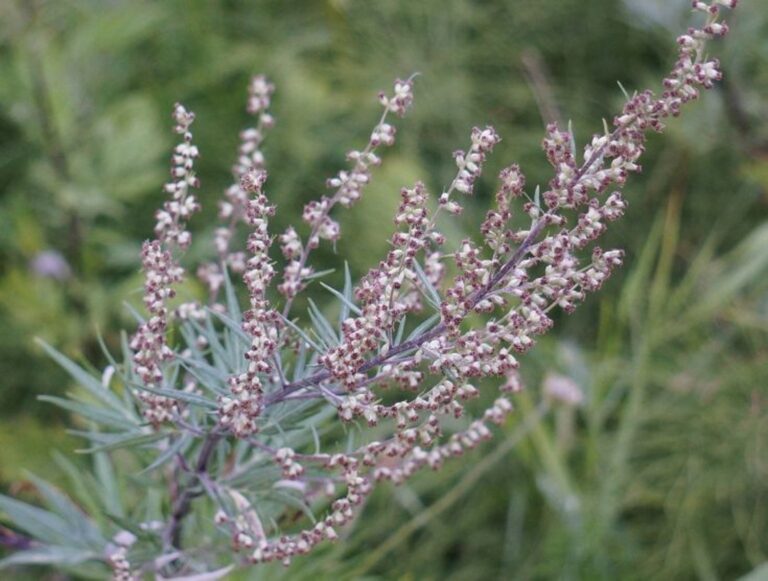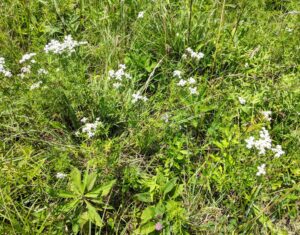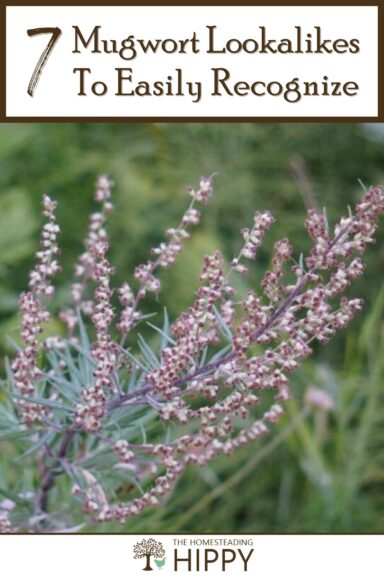Mugwort has to be one of the most fascinating plants in the world. Beloved and used since antiquity for cooking, for flavoring drinks, and for various ceremonial purposes, it’s also known for its pretty stands of flowers and delicate, enticing aroma.

It can even be used as an all-natural insecticide!
Amazing stuff, and getting into a deep dive about Mugwort is going to take so much room we’ve got to save it for another article.
But today, all you need to know is that Mugwort has quite a few look-alikes that you need to know about, as some of them are dangerous.
Keep reading, and I’ll tell you all about seven of the most common Mugwort imposters and how to identify them…
Table of Contents
1. Common Ragweed (Ambrosia artemisiifolia)
Common ragweed is native to North America and is infamous and hated as one of the worst and most prolific allergens.
It thrives in disturbed soils, and is found all over along roadsides, in fields and taking over neglected cropland.
You might easily confuse common ragweed with Mugwort because of their similar overall appearance, but here’s how you can tell them apart easily enough with close inspection. Just don’t forget your antihistamines!
Common Ragweed has deeply lobed leaves that are light green on top and white or pale green underneath, unlike Mugwort’s uniformly dark green leaves.
Some Mugwort species show a silvery, scale-like underside too, which is unique to the genus. Common ragweed also produces small, greenish flowers that form dense clusters at the very top of the plant.
And unlike Mugwort, which has a distinctive herbal aromatic smell, common ragweed lacks any noticeable scent.
As said, although this plant isn’t dangerous it is a major allergen. Its pollen causes dreadful hay fever and other allergic reactions in a big portion of the population, so if you see it growing in the area, you know you could be in for a rough allergy season!

2. Yarrow (Achillea millefolium)
Yarrow, also known as Achillea millefolium, is a perennial herb native to Europe, Asia, and North America, and is a plant with a history almost as storied as Mugwort.
Yarrow has small, tightly packed clusters of white or pink flowers, and the leaves are finely dissected with a fern-like appearance, It tends to be found growing in meadows, pastures, and along roadsides.
Telling the two apart is simple enough if you look at the flowers and the leaves. Mugwort has tiny, yellow to reddish-brown flowers and leaves that alternate and branch antler-like along the length of the stem.
Yarrow is also a safe plant, and is renowned for its usefulness in various first-aid preparations.
In fact, It’s is said to have been reportedly used to help staunch bleeding from wounds. Interesting stuff!
3. Wormwood (Artemisia absinthium)
Wormwood is a plant with historical uses that are inversely famous to Mugwort’s. You might say it is the equally well known but infamous cousin!
At first glance, you might also mistake wormwood for Mugwort. Indeed, they both even belong to the Artemisia genus.
Wormwood is likewise a perennial plant native to Eurasia and North Africa, and it thrives in some of the same places that Mugwort can.
Wormwood even has silky, silvery leaves that are pinnately divided, quite similar to Mugwort! Getting pretty tough to distinguish them, yes?
Luckily, wormwood’s leaves are generally more silver and even less green than Mugwort’s. The flowers of wormwood are also consistently yellow, while Mugwort’s are reddish-brown or yellow.
Also, know that both plants have a strong aroma, but wormwood’s scent is bitterer and far less pleasant than Mugwort’s to most folks.
Wormwood is also safe to handle, generally, but should be used cautiously due to its high thujone content.
If you couldn’t tell from the scientific name up above, wormwood was also traditionally used in the making of absinthe, a potent alcoholic beverage popular in the 19th and early 20th centuries, and one making a comeback today with hipsters.
I despise the strong licorice taste, of the stuff, but some seem to like it.
4. Motherwort (Leonurus cardiaca)
Motherwort, or Leonurus cardiaca, could potentially be mistaken for Mugwort at a quick glance since it shares an overall shape and the arrangement of the leaves.
But Motherwort has tall, hairy stems with lobed leaves, that are more heart-shaped compared to the deeply lobed and creased leaves of Mugwort.
Also, motherwort has totally distinctive pink to lilac flowers arranged in whorls all around the stem, unlike Mugwort’s small, yellow or red-brown clustered flowers.
Motherwort is native to Central Asia and southeastern Europe, but is now found worldwide.
It’s safe to handle, and has been used by indigenous cultures for centuries, particularly for women’s health.
A fact which provided the plant its common name. Today, it turns out our ancestors might have been on to something: extractives of the plant show promise for making medicine that can help with uterine diseases!
5. Chrysanthemum (Chrysanthemum indicum)
Chrysanthemums, affectionately known as “mums” by legions of well-intentioned housewives that set out to buy and then kill them every year, are known for their dense, pretty and vivid flowers.
Native primarily to subtropical and temperate areas of Asia and northeastern Europe, they’re found around the world and are an extremely common decorative plant.
You might mistake Mums for Mugwort at first glance, and they even share a plant family, Asteraceae.
However, a closer look will easily reveal differences: Chrysanthemums have a distinct, bushy growth habit with deeply lobed leaves. That is somewhat similar to Mugwort, true.
But unlike Mugwort, chrysanthemums produce a huge and vibrant, dome of flowers across the whole of the plant, and do so in a myriad of colors.
Mums come in white, yellow, pink, purple, and red, a variety of colors that Mugwort cannot match.
Mums bloom from late summer into early fall, providing a huge burst of color when many other plants are starting to die back.
Chrysanthemums are safe to handle and grow, but not easy: they often fall victim to mistreatment and neglect. Although not done here in the US, some cultures use their leaves and flowers in teas and various dishes.
6. Southernwood (Artemisia abrotanum)
Southernwood, or Artemisia abrotanum, is another plant in the Artemisia genus that looks a bit like Mugwort.
Found originally in Europe, like so many other plants it has been introduced to many other parts of the world.
Like Mugwort, Southernwood has sharply divided, feathery leaves. However, Southernwood leaves are more gray-green in color and have a strong, citrus scent often compared to lemon, which sets it apart immediately from Mugwort.
The flowers of Southernwood are small and not as showy as those of Mugwort, though they are yellow, so you cannot depend on color alone to tell them apart.
Know that Southernwood is safe to handle, and has some old lore associated with it as a love potion of sorts.
It’s said that adding Southernwood to a drink or performing various rituals with it would make the object of the bearer’s desire go made with love – or lust!
This gave it old-fashioned, poetic nicknames you might have heard, variously called lad’s love or maid’s ruin. Pretty neat, but don’t try this nonsense yourself: it isn’t safe to consume!
7. Tansy (Tanacetum vulgare)
Hailing from temperate Europe and across much of Asia, this perennial, herbaceous flowering plant belongs to the aster family.
You might find that Tansy (Tanacetum vulgare) also bears some resemblance to Mugwort since it boasts somewhat-similar if fern-like foliage and also yellow, button-like flowers.
The flowers are what make it look so similar to Mugwort.
While both plants have small, clustered flowers, Tansy’s are more button-like and boldly yellow, whereas Mugwort’s flowers tend to be reddish-brown or yellow and rarely as bright.
However, aside from the foliage, Tansy grows taller and straighter, typically reaching heights of 1 to 5 feet tall, and its foliage emits a strong aroma only when crushed, unlike Mugwort.
Tansy won’t hurt you if you don’t eat it, but it’s worth noting that it can form very dense ground cover and quickly degrade pasturage, a characteristic which has made it the hated foe of livestock keepers the world over.
It’s so pervasive it has even impeded reforestation efforts! But on the positive side, Tansy is known as a potassium-fixing plant, helping to improve soil quality overall even as it crowds out other plants.
It’s also known to naturally and safely deter many harmful garden and crop pests, meaning a controlled grow in your own garden might keep your veggie killers at bay.
Of course, you might have bigger issues if it jumps its bound, though!

Tim is a farm boy with vast experience on homesteads, and with survival and prepping. He lives a self-reliant lifestyle along with his aging mother in a quiet and very conservative little town in Ohio. He teaches folks about security, prepping and self-sufficiency not just through his witty writing, but also in person.
Find out more about Tim and the rest of the crew here.
